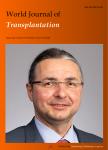Optimal stem cell source for allogeneic stem cell transplantation for hematological malignancies
Optimal stem cell source for allogeneic stem cell transplantation for hematological malignancies作者机构:Department of Paediatrics and Adolescent Medicinethe University of Hong KongQueen Mary Hospital
出 版 物:《World Journal of Transplantation》 (世界移植杂志)
年 卷 期:2013年第3卷第4期
页 面:99-112页
学科分类:10[医学]
基 金:Supported by The University of Hong Kong
主 题:hematopoietic stem cell transplantation bone marrow peripheral blood stem cell cord blood hematological malignancy
摘 要:Hematopoietic stem cell transplant(HSCT) is a standard treatment for many hematological *** different sources of stem cells, namely bone marrow(BM), peripheral blood stem cells(PBSC) and cord blood(CB) can be used for HSCT, and each has its own advantages and disadvantages. Randomized controlled trials(RCTs) suggest that there is no significant survival advantage of PBSC over BM in Human Leukocyte Antigen-matched sibling transplant for adult patients with hematological malignancies. PBSC transplant probably results in lower risk of relapse and hence better disease-free survival, especially in patients with high risk disease at the expense of higher risks of both severe acute and chronic graft-versus-host disease(GVHD).In the unrelated donor setting, the only RCT available suggests that PBSC and BM result in comparable overall and disease-free survivals in patients with hematological malignancies; and PBSC transplant results in lower risk of graft failure and higher risk of chronic *** level evidence is not available for CB in comparison to BM or PBSC. The risks and benefits of different sources of stem cells likely change with different conditioning regimen, strategies for prophylaxis and treatment of GVHD and manipulation of grafts. The recent success and rapid advance of double CB transplant and haploidentical BM and PBSC transplants further complicate the selection of stem cell source. Optimal selection requires careful weighing of the risks and benefits of different stem cell source for each individual recipient and donor. Detailed counseling of patient and donor regarding risks and benefits in the specific context of the patient and transplant method is essential for informed decision making.




